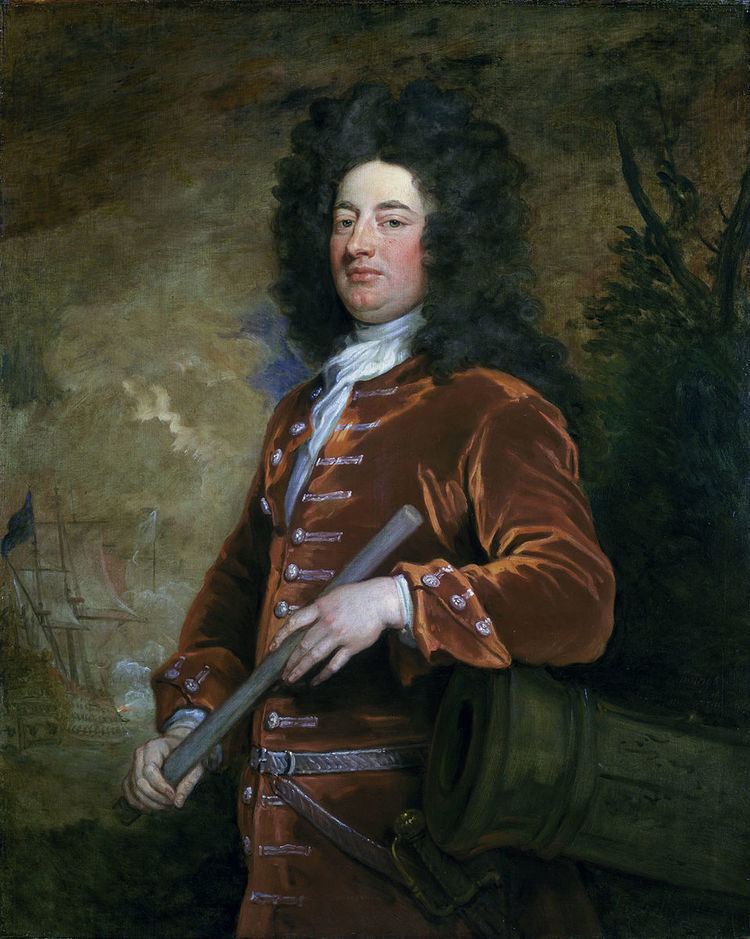Name John Jennings Died December 23, 1743 Rank Admiral | Service/branch Royal Navy | |
 | ||
Commands held HMS St PaulHMS ExperimentHMS VictoryHMS MaryHMS ChichesterHMS PlymouthHMS KentHMS St GeorgeGreenwich Hospital Battles/wars War of Spanish Succession Battles and wars | ||
Admiral Sir John Jennings (1664 – 23 December 1743) was an officer in the English Royal Navy, a Lord of the Admiralty and Member of Parliament. He distinguished himself early through his service in the Royal Navy, and was regarded as one of the greatest seamen of his age, despite having few opportunities to distinguish himself in battle as a fleet commander.
Naval career
Sir John Jennings was descended from a Shropshire family which had suffered for its adherence to the Royalist cause during the English Civil War. He was appointed a lieutenant on HMS Pearl in 1687, and served with the same rank in HMS St David and HMS Swallow, before being promoted to the command of the St Paul, a fireship.
In 1690 he was made captain of the newly launched HMS Experiment, of 32 guns, and employed in cruising off the coast of Ireland, where he intercepted a number of small vessels which were being used as transports by James II's forces. In 1693, Jennings was nominated captain of the Victory, flagship of Sir John Ashby; later the same year he was transferred to the 62-gun HMS Mary, in which he went to the Mediterranean with Admiral Russell. In 1696, he was removed to the Chichester, of 80 guns; and, in the following year, was entrusted with the command of the Plymouth, with which he captured a St Malo privateer. Shortly afterwards, together with the frigate HMS Rye, he fell in with three French ships: one quickly surrendered, and Jennings, leaving the Rye to look after their prize, pursued the other two and succeeded in compelling one to strike her flag after a vigorous defence. Having conducted their prizes to port, the Rye and the Plymouth fell in with the Severn, a British man-of-war, and the three ships steered together for the coast of France, where they took five vessels laden with wine from Bordeaux, and a small ship of war.
On the outbreak of the War of Spanish Succession, Jennings commanded HMS Kent under Admiral Rooke at Cadiz and Vigo (of 70 guns) in 1702, where he played a part in the destruction of the Franco-Spanish fleet. He took part in the capture of Gibraltar, and was captain of the 96-gun HMS St George at the Battle of Malaga in 1704. He was knighted for his exploits by Queen Anne on 9 September 1704, and having been promoted to rear admiral in 1705, became Commander-in-Chief of the Jamaica Station in 1706. He was promoted to vice admiral in 1708 and admiral in 1709. His attack on Tenerife in 1706 was unsuccessful. He commanded the fleet off Lisbon in 1708-1710, and was later Commander-in-Chief in the Mediterranean.
Jennings entered Parliament in 1705 and was regarded as a useful member of the House of Commons, in which he represented Queenborough, Portsmouth and Rochester - all boroughs with strong naval connections where his selection as an MP might be taken as a mark of the esteem in which his service record was held, but equally as an indication of the influence he could potentially wield on their behalf as a senior serving officer and later as a naval administrator. He was a Lord of the Admiralty from 1714 until he resigned in 1727 because his increasing deafness was preventing him from adequately fulfilling the duties. He was also appointed governor of Greenwich Hospital and Ranger of Greenwich Park from 1720, and presented the marble statue of George II by Rysbrack which stands in the Grand Square of the Hospital.
Jennings died at the age of 79, and was buried in Westminster Abbey.
